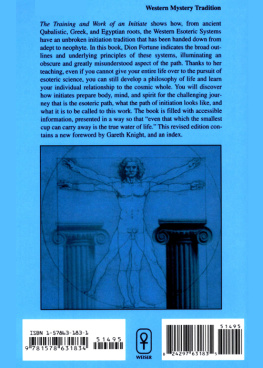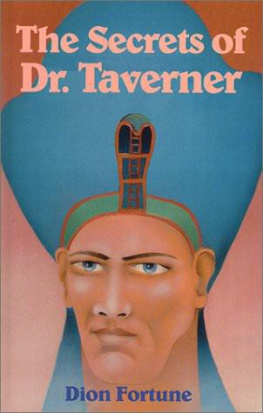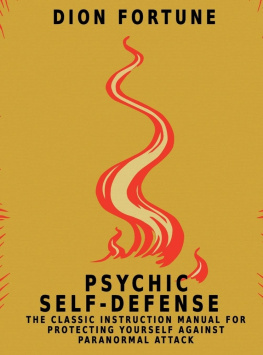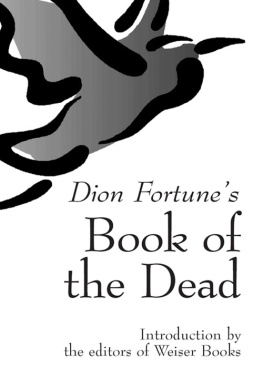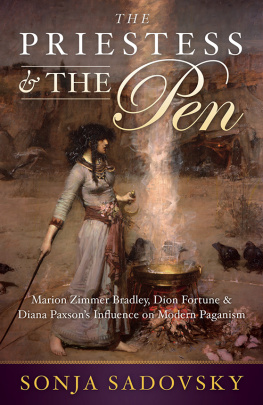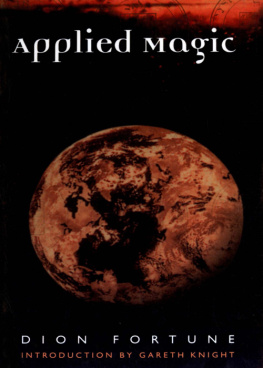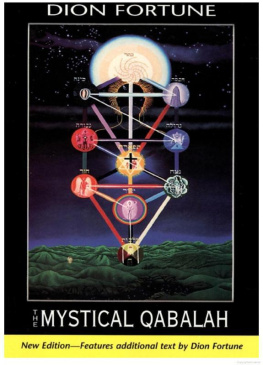Other books by Dion Fortune
Occult Study
Machinery of the Mind
The Esoteric Philosophy of Love and Marriage
Psychology of the Servant Problem
The Soya Bean
Esoteric Orders and Their Work
The Problem of Purity
Sane Occultism (to publish as What is Occultism? Weiser, 2001)
Training and Work of an Initiate
Mystical Meditations on the Collects
Spiritualism in the Light of Occult Science
Psychic Self-Defense
Through the Gates of Death
GlastonburyAvalon of the Heart
The Mystical Qabalah
Practical Occultism in Daily Life
Applied Magic
Aspects of Occultism
The Magical Battle of Britain
Occult Fiction
The Demon Lover
The Goat-Foot God
Moon Magic
The Sea Priestess
The Secrets of Dr. Taverner
The Winged Bull
First published in 2000 by
Samuel Weiser, Inc.
with offices at
Red Wheel/Weiser, LLC
500 Third Street, Suite 230
San Francisco, CA 94107
www.redwheelweiser.com
10 09 08 07 06
15 14 13 12 11 10 9 8 7 6 5 4 3
Text copyright 1967 Society of Inner Light
Foreword copyright 2000 Samuel Weiser, Inc.
All rights reserved. No part of this publication may be reproduced or transmitted in any form or by any means, electronic or mechanical, including photocopying, recording, or by any information storage and retrieval system, without permission in writing from Red Wheel/Weiser. Reviewers may quote brief passages. First published in 1930 by Rider & Co., 1930.
Dion Fortune is a registered trademark
Library of Congress Cataloging-in-Publication Data:
Fortune, Dion.
Training and work of an initiate / Dion Fortune.Rev. ed.
p. cm.
Includes index
ISBN 1-57863-183-1 (pbk. : alk. paper)
1. Occultism. 2. Fraternity of the Inner Light. I. Title.
BF1411.F59 2000
131dc21 00-040896
Printed in the United States of America
MG
The paper used in this publication meets the minimum requirements of the American National Standard for Information SciencesPermanence of Paper for Printed Library Materials Z39.48-1992(R1997).
www.redwheelweiser.com/newsletter
CONTENTS
by Gareth Knight
FOREWORD
BY GARETH KNIGHT
F IRST published in 1930, The Training and Work of an Initiate, along with its companion volume, The Esoteric Orders and Their Work (1928), represented the first serious statement of Dian Fortune's aims and ideals in launching her famous school, the Fraternity of the Inner Light.
In her view, the Fraternity was to be nothing less than an Esoteric Order consisting of trained Initiates. The Esoteric Orders and Their Work thus presents her vision of what such groups should do, and The Training and Work of an Initiate describes how its members should be trained to fulfill this group purpose.
This training is not meant to be confined to an inner charmed circle at the heart of an Esoteric Order however. If it is to mean anything, it needs to take into its ambit anyone who feels the least stirrings toward the work and ideals of an initiate. Indeed if we take seriously the tradition that it takes at least three lives to make an initiate, then some form of appropriate training and guidance must be available to those who might be still on one of those preparatory lives leading to the door of initiation.
In practical application of this, Dian Fortune pursued her publishing and lecturing activities, and also developed an extensive Outer Court for her Fraternity, with a body of affiliates and associates who received an appropriate selection of private teaching and knowledge papers, along with The Inner Light Magazine.
As in most things connected with the Mysteries, the Outer Court fell naturally into a three-tier system. An inner ring consisted of students enrolled upon the preliminary study course leading to full membership. Affiliates were mostly students who had completed the study course, but who, for various reasons domestic or geographic, could not or did not wish to take the final step of initiation. Associates were any sympathetic members of the public willing to pay a small subscription in return for selected papers and newsletters, and it was considered no small privilege to be formally linked in this way with a genuinely contacted esoteric fraternity.
The actual implementation of the system varied over the years. Like all institutions, esoteric fraternities develop and adapt to meet the needs of the times if they are to survive in anything but a quiescent or moribund form. Thus at the beginning of its existence the ideal of an enclosed community was paramount in the organisation of the Fraternity of the Inner Light, in fact its first chosen title was the Community of the Inner Light. Gradually it came to be less enclosed during Dion Fortune's lifetime, until eventually the concept was abandoned in favour of the belief that the primary role of an initiate should be to lead a normal life in the world, rather than to emulate the role of an incumbent of an enclosed religious order.
Until this realisation came about, there tended to be a tacit assumption that the Path of the Hearth-Fire was somehow inferior to that of a fully committed and fully enclosed initiate, devoted exclusively to esoteric work with no outer world distractions of family, work, and friends. The view today, on the contrary, tends to see the enclosed initiate as somewhat in danger of being out of touch with the times, even to the extent of seeking a subjective refuge from the challenges of the outer world. The modern initiate is expected to take a full part in the ways of the world, striving to exemplify the spiritual life within it.
In her chapter upon the Path of the Hearth-Fire, Dion Fortune strikes the right balance, seeing neither the one nor the other as superior, but each in their way as a valid expression of the life of an initiate. It is true that she is still sufficiently imbued with the community idea to see the issue in terms of one of conflict: Which is the higher duty, the service of the Masters or the service of the family and home?
She poses this as the big question, apparently without considering the possibility that the conflict may be an illusory one. She
Initiation, therefore, is a state of mind, rather than a pattern of circumstances. As she explains in her two chapters on the way of initiation and preparation for it, it is a matter of the illumination of the soul by an inner light. This illumination implies becoming conscious of an idea within the Divine Mind and thereby expressing it in a concrete form that is embodied in outer life.
It follows that the environmental circumstances in which that illumination is expressed is somewhat of a secondary factor. We can be initiates in a temple, in a church, in the street, in the home, in a hospital, in a prison, in any of the circumstances of contemporary life. In a sense, it is not what we do that counts, but the way that we do itor how and where we let our light shine. And this depends upon what we are, or what we aspire to be. In Dion Fortune's terms, this is to be an illuminated initiate.
There are, of course, different grades of initiate and adept, and this difference is demonstrated by the life style rather than the possession of any high-sounding titles or magnificent ritual regaliathe failure to realise which has caused a considerable amount of self-deception within the extensive fringes of occultism, and even alas in hallowed circles where those concerned really ought to have known better.
Next page
